MITSUBISHI COLT 2011 Owner's Manual (in English)
Manufacturer: MITSUBISHI, Model Year: 2011, Model line: COLT, Model: MITSUBISHI COLT 2011Pages: 274, PDF Size: 17.88 MB
Page 231 of 274
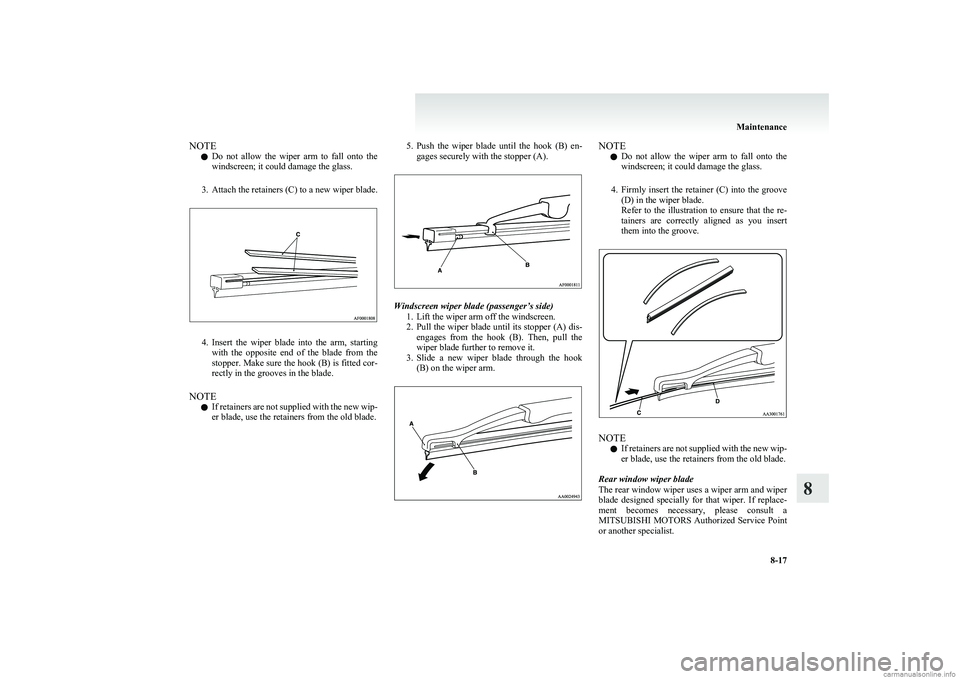
NOTEl Do not allow the wiper arm to fall onto the
windscreen; it could damage the glass.
3. Attach the retainers (C) to a new wiper blade.
4.Insert the wiper blade into the arm, starting
with the opposite end of the blade from the
stopper. Make sure the hook (B) is fitted cor-
rectly in the grooves in the blade.
NOTE l If retainers are not supplied with the new wip-
er blade, use the retainers from the old blade.
5. Push the wiper blade until the hook (B) en-
gages securely with the stopper (A).
Windscreen wiper blade (passenger’s side)
1. Lift the wiper arm off the windscreen.
2. Pull the wiper blade until its stopper (A) dis-
engages from the hook (B). Then, pull the
wiper blade further to remove it.
3. Slide a new wiper blade through the hook
(B) on the wiper arm.
NOTE
l Do not allow the wiper arm to fall onto the
windscreen; it could damage the glass.
4. Firmly insert the retainer (C) into the groove
(D) in the wiper blade.
Refer to the illustration to ensure that the re-
tainers are correctly aligned as you insert
them into the groove.
NOTE
l If retainers are not supplied with the new wip-
er blade, use the retainers from the old blade.
Rear window wiper blade
The rear window wiper uses a wiper arm and wiper
blade designed specially for that wiper. If replace-
ment becomes necessary, please consult a
MITSUBISHI MOTORS Authorized Service Point
or another specialist.
Maintenance
8-17
8
Page 232 of 274
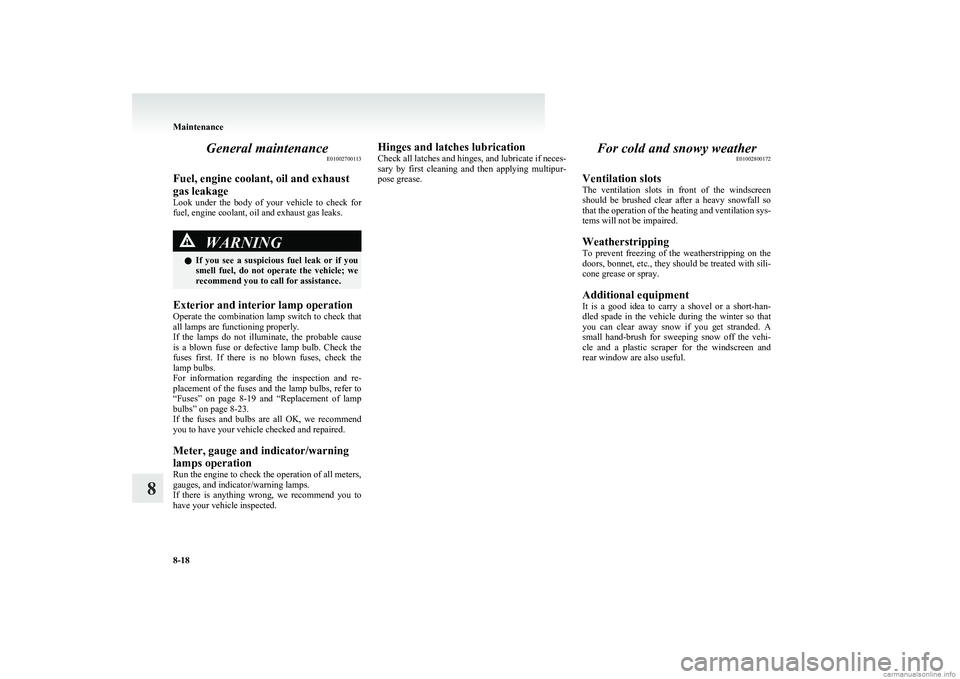
General maintenanceE01002700113
Fuel, engine coolant, oil and exhaust
gas leakage
Look under the body of your vehicle to check for
fuel, engine coolant, oil and exhaust gas leaks.WARNINGl If you see a suspicious fuel leak or if you
smell fuel, do not operate the vehicle; we
recommend you to call for assistance.
Exterior and interior lamp operation
Operate the combination lamp switch to check that
all lamps are functioning properly.
If the lamps do not illuminate, the probable cause
is a blown fuse or defective lamp bulb. Check the
fuses first. If there is no blown fuses, check the
lamp bulbs.
For information regarding the inspection and re-
placement of the fuses and the lamp bulbs, refer to
“ Fuses” on page 8-19 and “Replacement of lamp
bulbs” on page 8-23.
If the fuses and bulbs are all OK, we recommend
you to have your vehicle checked and repaired.
Meter, gauge and indicator/warning
lamps operation
Run the engine to check the operation of all meters,
gauges, and indicator/warning lamps.
If there is anything wrong, we recommend you to
have your vehicle inspected.
Hinges and latches lubrication
Check all latches and hinges, and lubricate if neces-
sary by first cleaning and then applying multipur-
pose grease.For cold and snowy weather E01002800172
Ventilation slots
The ventilation slots in front of the windscreen
should be brushed clear after a heavy snowfall so
that the operation of the heating and ventilation sys-
tems will not be impaired.
Weatherstripping
To prevent freezing of the weatherstripping on the
doors, bonnet, etc., they should be treated with sili-
cone grease or spray.
Additional equipment
It is a good idea to carry a shovel or a short-han-
dled spade in the vehicle during the winter so that
you can clear away snow if you get stranded. A
small hand-brush for sweeping snow off the vehi-
cle and a plastic scraper for the windscreen and
rear window are also useful.
Maintenance
8-18
8
Page 233 of 274
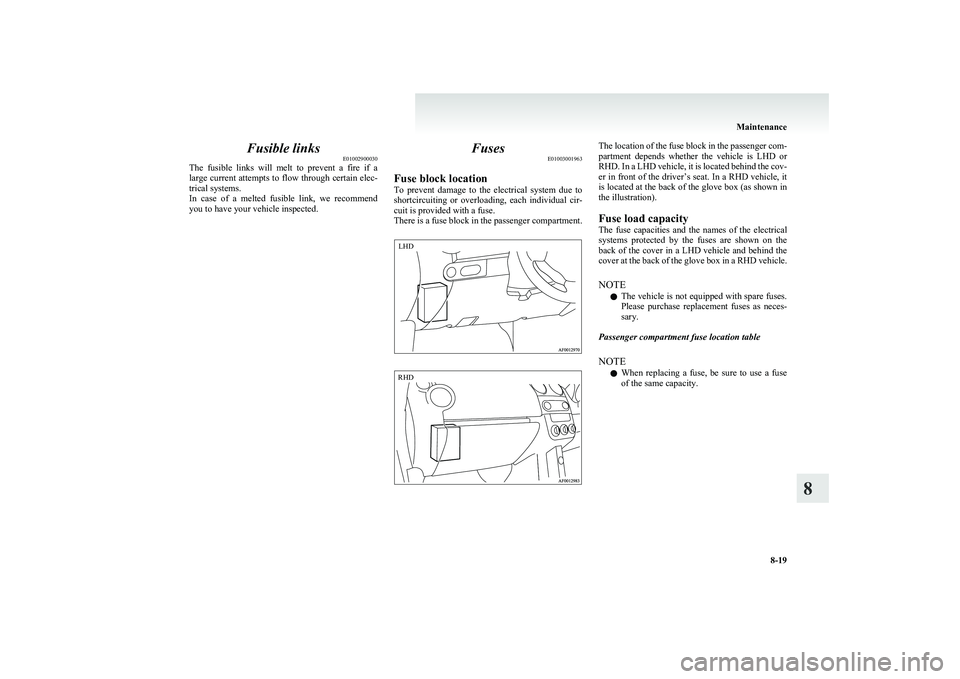
Fusible linksE01002900030
The fusible links will melt to prevent a fire if a
large current attempts to flow through certain elec-
trical systems.
In case of a melted fusible link, we recommend
you to have your vehicle inspected.Fuses E01003001963
Fuse block location
To prevent damage to the electrical system due to
shortcircuiting or overloading, each individual cir-
cuit is provided with a fuse.
There is a fuse block in the passenger compartment.The location of the fuse block in the passenger com-
partment depends whether the vehicle is LHD or
RHD. In a LHD vehicle, it is located behind the cov-
er in front of the driver’s seat. In a RHD vehicle, it
is located at the back of the glove box (as shown in
the illustration).
Fuse load capacity
The fuse capacities and the names of the electrical
systems protected by the fuses are shown on the
back of the cover in a LHD vehicle and behind the
cover at the back of the glove box in a RHD vehicle.
NOTE l The vehicle is not equipped with spare fuses.
Please purchase replacement fuses as neces-
sary.
Passenger compartment fuse location table
NOTE l When replacing a fuse, be sure to use a fuse
of the same capacity.
Maintenance
8-19
8LHD RHD
Page 234 of 274
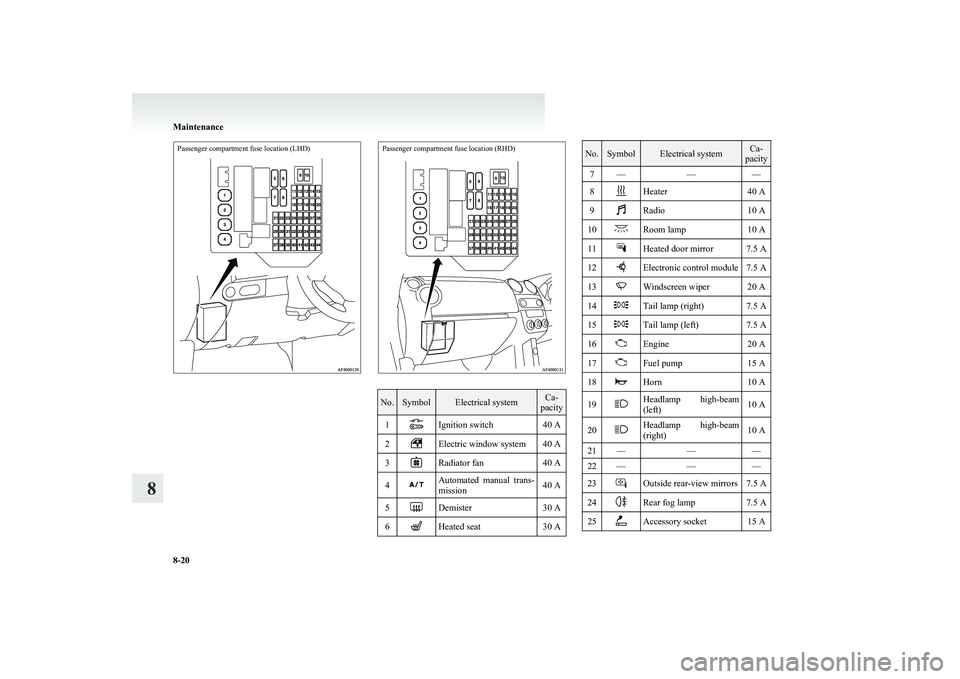
Passenger compartment fuse location (LHD)Passenger compartment fuse location (RHD)
No.SymbolElectrical systemCa-
pacity1Ignition switch40 A2Electric window system40 A3Radiator fan40 A4Automated manual trans-
mission40 A5Demister30 A6Heated seat30 ANo.SymbolElectrical systemCa-
pacity7———8Heater40 A9Radio10 A10Room lamp10 A11Heated door mirror7.5 A12Electronic control module7.5 A13Windscreen wiper20 A14Tail lamp (right)7.5 A15Tail lamp (left)7.5 A16Engine20 A17Fuel pump15 A18Horn10 A19Headlamp high-beam
(left)10 A20Headlamp high-beam
(right)10 A21———22———23Outside rear-view mirrors7.5 A24Rear fog lamp7.5 A25Accessory socket15 A
Maintenance
8-20
8
Page 235 of 274
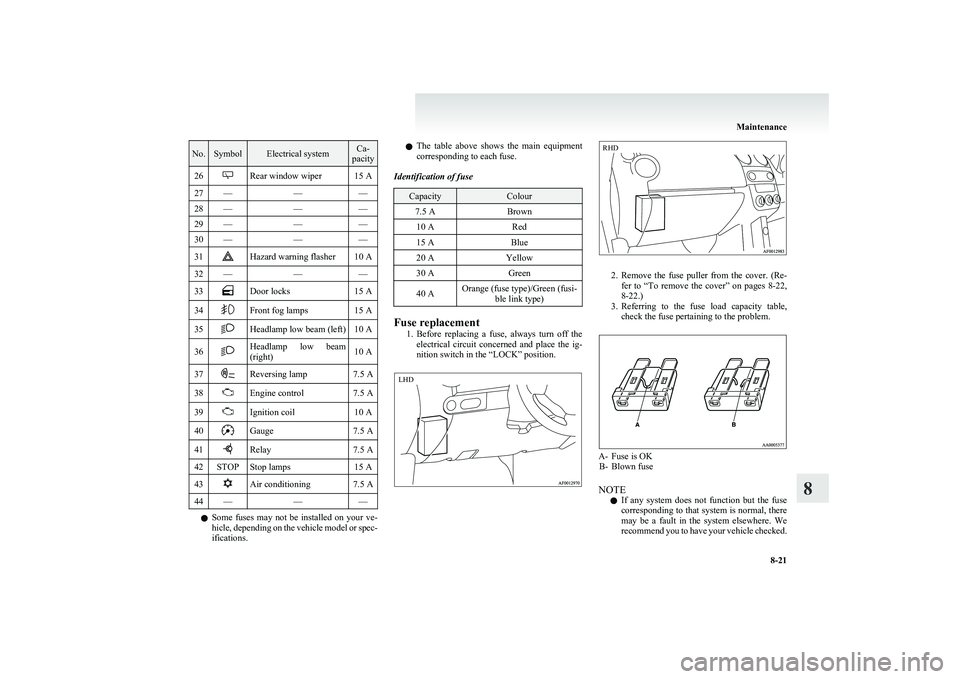
No.SymbolElectrical systemCa-
pacity26Rear window wiper15 A27———28———29———30———31Hazard warning flasher10 A32———33Door locks15 A34Front fog lamps15 A35Headlamp low beam (left)10 A36Headlamp low beam
(right)10 A37Reversing lamp7.5 A38Engine control7.5 A39Ignition coil10 A40Gauge7.5 A41Relay7.5 A42STOPStop lamps15 A43Air conditioning7.5 A44———
l Some fuses may not be installed on your ve-
hicle, depending on the vehicle model or spec-
ifications.
l The table above shows the main equipment
corresponding to each fuse.
Identification of fuseCapacityColour7.5 ABrown10 ARed15 ABlue20 AYellow30 AGreen40 AOrange (fuse type)/Green (fusi- ble link type)
Fuse replacement
1.Before replacing a fuse, always turn off the
electrical circuit concerned and place the ig-
nition switch in the “LOCK” position.
2. Remove the fuse puller from the cover. (Re-
fer to “To remove the cover” on pages 8-22,
8-22.)
3. Referring to the fuse load capacity table,
check the fuse pertaining to the problem.
A- Fuse is OK B- Blown fuse
NOTE l If any system does not function but the fuse
corresponding to that system is normal, there
may be a fault in the system elsewhere. We
recommend you to have your vehicle checked.
Maintenance
8-21
8 LHD RHD
Page 236 of 274
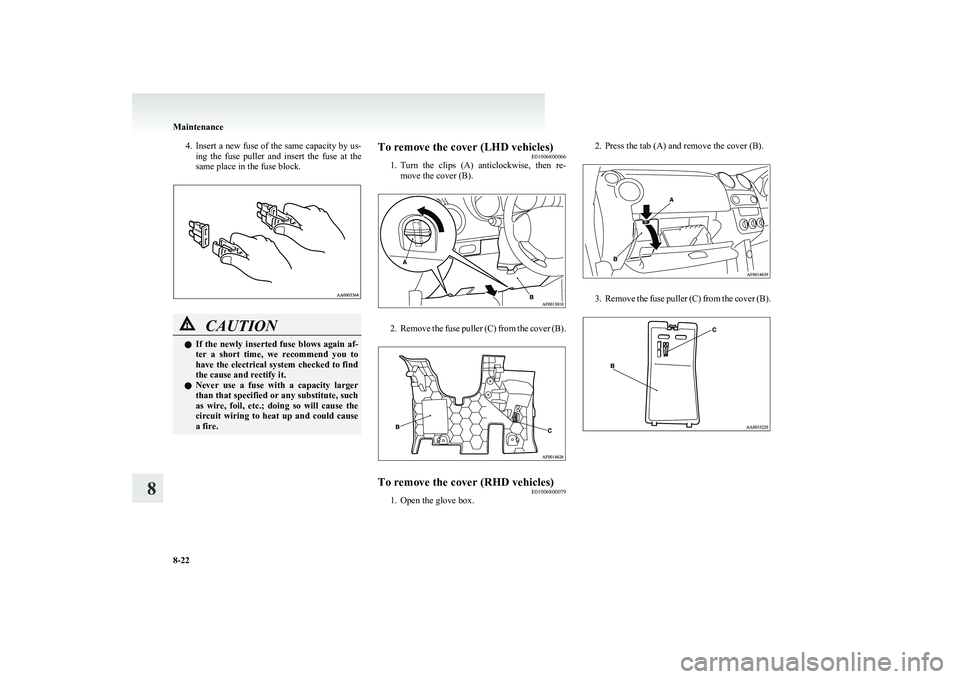
4.Insert a new fuse of the same capacity by us-
ing the fuse puller and insert the fuse at the
same place in the fuse block.CAUTIONl If the newly inserted fuse blows again af-
ter a short time, we recommend you to
have the electrical system checked to find
the cause and rectify it.
l Never use a fuse with a capacity larger
than that specified or any substitute, such
as wire, foil, etc.; doing so will cause the
circuit wiring to heat up and could cause
a fire.To remove the cover (LHD vehicles) E01006800066
1. Turn the clips (A) anticlockwise, then re-
move the cover (B).
2. Remove the fuse puller (C) from the cover (B).
To remove the cover (RHD vehicles)
E01006800079
1. Open the glove box.
2. Press the tab (A) and remove the cover (B).
3.Remove the fuse puller (C) from the cover (B).
Maintenance
8-22
8
Page 237 of 274
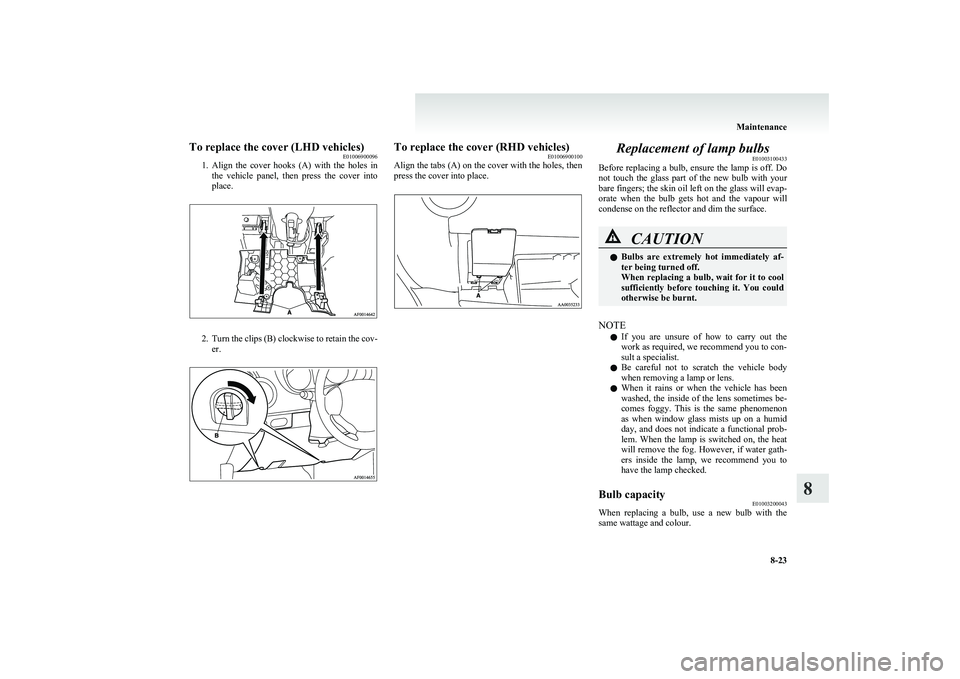
To replace the cover (LHD vehicles)E01006900096
1. Align the cover hooks (A) with the holes in
the vehicle panel, then press the cover into
place.
2. Turn the clips (B) clockwise to retain the cov-
er.
To replace the cover (RHD vehicles) E01006900100
Align the tabs (A) on the cover with the holes, then
press the cover into place.Replacement of lamp bulbs E01003100433
Before replacing a bulb, ensure the lamp is off. Do
not touch the glass part of the new bulb with your
bare fingers; the skin oil left on the glass will evap-
orate when the bulb gets hot and the vapour will
condense on the reflector and dim the surface.CAUTIONl Bulbs are extremely hot immediately af-
ter being turned off.
When replacing a bulb, wait for it to cool
sufficiently before touching it. You could
otherwise be burnt.
NOTE
l If you are unsure of how to carry out the
work as required, we recommend you to con-
sult a specialist.
l Be careful not to scratch the vehicle body
when removing a lamp or lens.
l When it rains or when the vehicle has been
washed, the inside of the lens sometimes be-
comes foggy. This is the same phenomenon
as when window glass mists up on a humid
day, and does not indicate a functional prob-
lem. When the lamp is switched on, the heat
will remove the fog. However, if water gath-
ers inside the lamp, we recommend you to
have the lamp checked.
Bulb capacity E01003200043
When replacing a bulb, use a new bulb with the
same wattage and colour.
Maintenance
8-23
8
Page 238 of 274
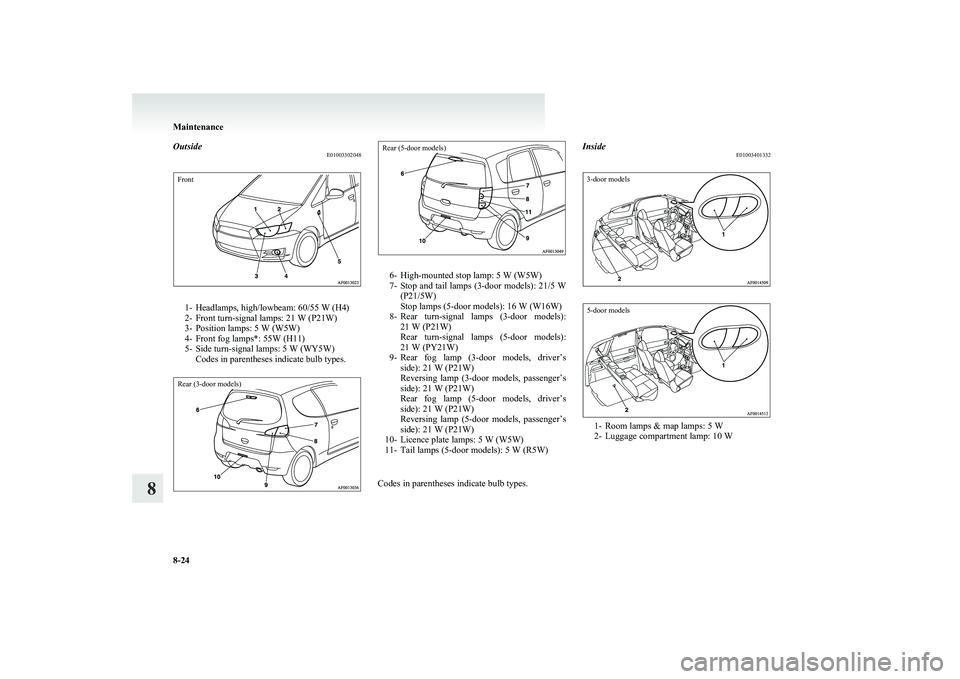
OutsideE01003302048Front
1- Headlamps, high/lowbeam: 60/55 W (H4)
2- Front turn-signal lamps: 21 W (P21W)
3- Position lamps: 5 W (W5W)
4- Front fog lamps*: 55W (H11)
5- Side turn-signal lamps: 5 W (WY5W) Codes in parentheses indicate bulb types.
Rear (3-door models)Rear (5-door models)
6- High-mounted stop lamp: 5 W (W5W)
7- Stop and tail lamps (3-door models): 21/5 W
(P21/5W)
Stop lamps (5-door models): 16 W (W16W)
8- Rear turn-signal lamps (3-door models):
21 W (P21W)
Rear turn-signal lamps (5-door models):
21 W (PY21W)
9- Rear fog lamp (3-door models, driver’s
side): 21 W (P21W)
Reversing lamp (3-door models, passenger’s
side): 21 W (P21W)
Rear fog lamp (5-door models, driver’s
side): 21 W (P21W)
Reversing lamp (5-door models, passenger’s
side): 21 W (P21W)
10- Licence plate lamps: 5 W (W5W)
11- Tail lamps (5-door models): 5 W (R5W)
Codes in parentheses indicate bulb types.
Inside E010034013323-door models5-door models
1- Room lamps & map lamps: 5 W
2- Luggage compartment lamp: 10 W
Maintenance
8-24
8
Page 239 of 274
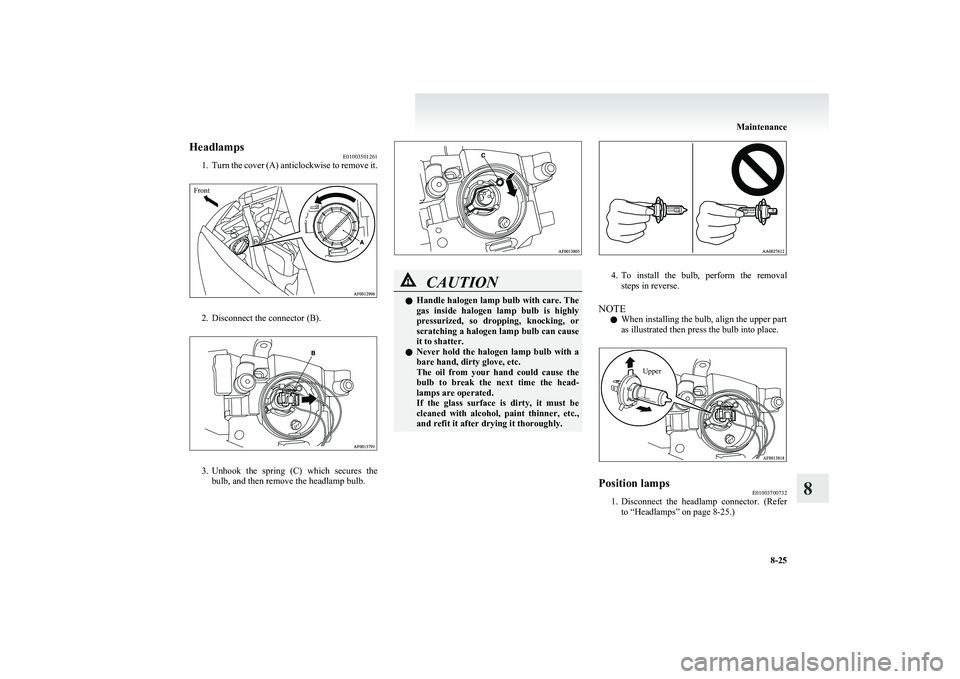
HeadlampsE01003501261
1. Turn the cover (A) anticlockwise to remove it.Front
2. Disconnect the connector (B).
3.Unhook the spring (C) which secures the
bulb, and then remove the headlamp bulb.
CAUTIONl Handle halogen lamp bulb with care. The
gas inside halogen lamp bulb is highly
pressurized, so dropping, knocking, or
scratching a halogen lamp bulb can cause
it to shatter.
l Never hold the halogen lamp bulb with a
bare hand, dirty glove, etc.
The oil from your hand could cause the
bulb to break the next time the head-
lamps are operated.
If the glass surface is dirty, it must be
cleaned with alcohol, paint thinner, etc.,
and refit it after drying it thoroughly.
4. To install the bulb, perform the removal
steps in reverse.
NOTE l When installing the bulb, align the upper part
as illustrated then press the bulb into place.
UpperPosition lamps E01003700732
1.Disconnect the headlamp connector. (Refer
to “Headlamps” on page 8-25.)
Maintenance
8-25
8
Page 240 of 274
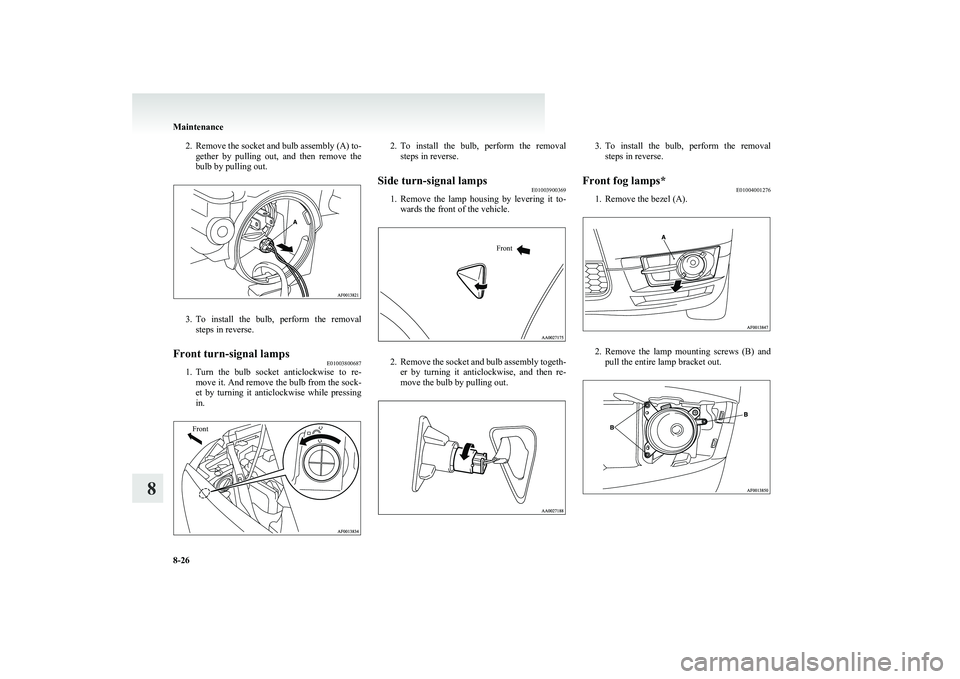
2.Remove the socket and bulb assembly (A) to-
gether by pulling out, and then remove the
bulb by pulling out.
3. To install the bulb, perform the removal
steps in reverse.
Front turn-signal lamps E01003800687
1.Turn the bulb socket anticlockwise to re-
move it. And remove the bulb from the sock-
et by turning it anticlockwise while pressing
in.
Front2. To install the bulb, perform the removal
steps in reverse.Side turn-signal lamps E01003900369
1.Remove the lamp housing by levering it to-
wards the front of the vehicle.
Front
2. Remove the socket and bulb assembly togeth-
er by turning it anticlockwise, and then re-
move the bulb by pulling out.
3. To install the bulb, perform the removal
steps in reverse.Front fog lamps* E01004001276
1. Remove the bezel (A).
2.Remove the lamp mounting screws (B) and
pull the entire lamp bracket out.
Maintenance
8-26
8